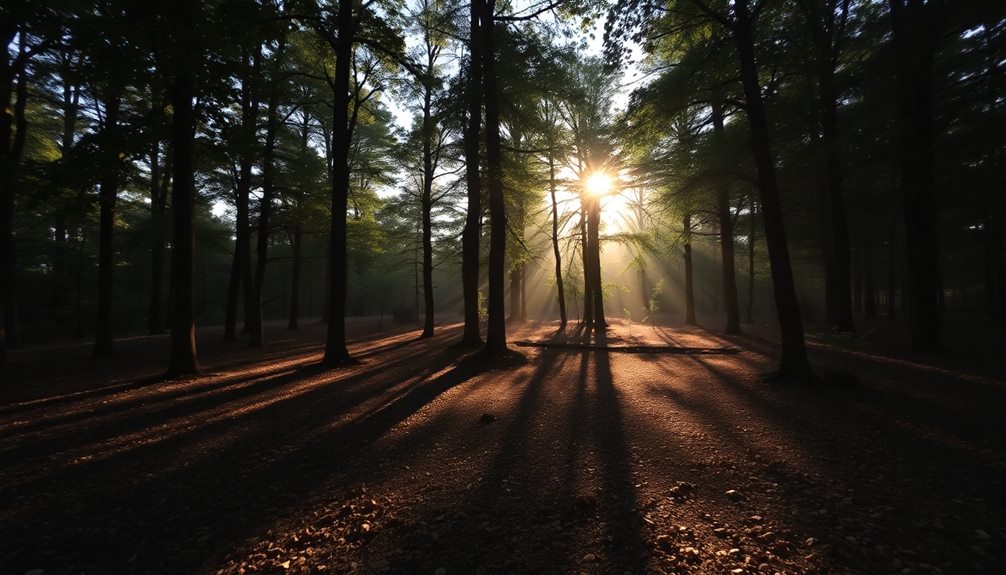When you analyze light and shadow, you uncover how they interact to influence perception. Light travels in straight lines, shaping shadows based on intensity and angle. You'll notice warm light produces cool shadows, while cool light yields warmth. Understanding different shadow types—like cast, form, and core shadows—helps create depth in your work. Observing real-life conditions sharpens your skills and enhances realism. Experimenting with layering colors can add texture and vibrancy. By recognizing these principles, you'll develop a deeper appreciation and mastery of light and shadow techniques that elevate your artistic creations. Explore further to reveal more insights!
Key Takeaways
- Understanding light behavior, including its straight-line travel and intensity, is crucial for accurate shadow analysis.
- Differentiating between cast shadows and form shadows helps in creating depth and realism in artwork.
- Observing changes in shadow length and clarity throughout the day enhances comprehension of light dynamics.
- Color temperature significantly influences shadow appearance, with warm light producing cool shadows and vice versa.
- Practical techniques, such as layering colors and using reference images, improve shadow painting skills and overall artistic quality.
Fundamentals of Light and Shadow
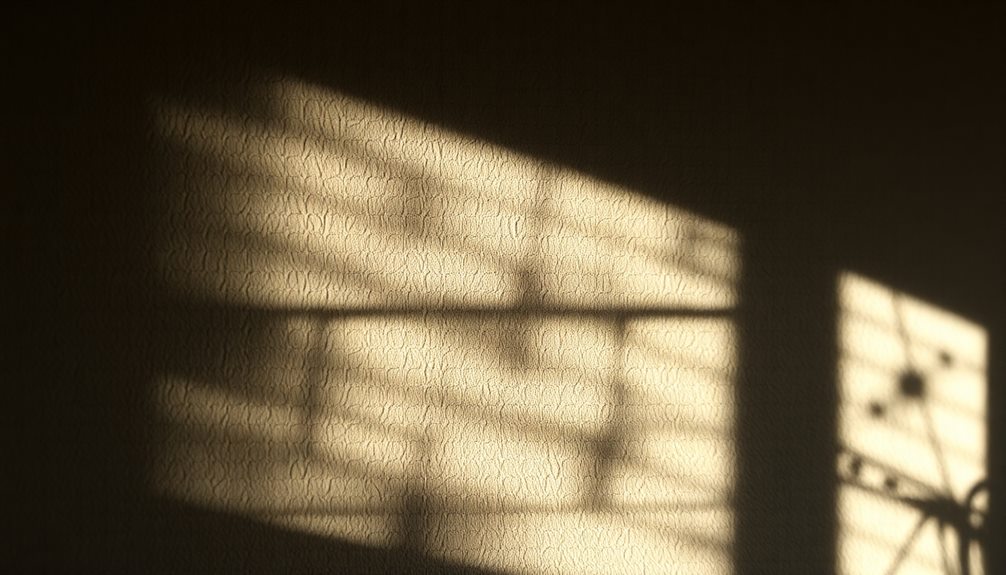
Understanding the fundamentals of light and shadow is essential for any artist, as they play an important role in creating depth and realism in your work. White light is produced by combining all colors, while shadows are the absence of light, appearing black.
It's significant to differentiate between light, which mixes to create white, and pigment, which mixes to create black.
As you explore light and shadow, consider the various light sources in your environment. Different sources can cast shadows that exhibit a range of colors and temperatures. For instance, warm light often results in cool shadows, while cool light can create warm shadows.
This interplay can dramatically alter the mood and perception of your artwork.
Observational practice is key to refining your understanding. Pay attention to how shadows change based on context and surrounding hues.
This awareness will enhance your ability to depict realistic light and shadow in your pieces. By mastering these fundamentals, you'll create more dynamic and engaging artwork that resonates with viewers, drawing them into the depth and dimension of your creations.
Color Relationships and Perception
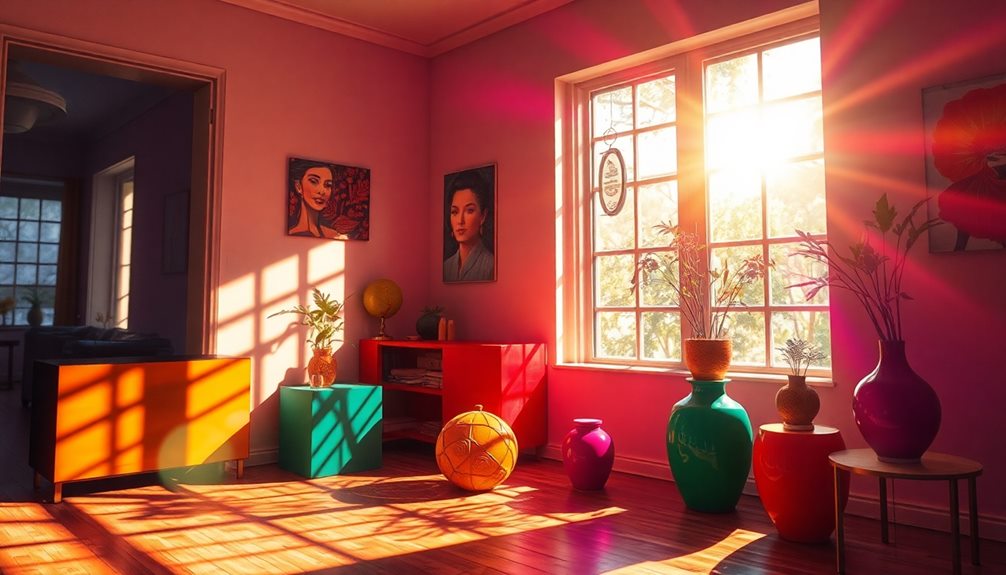
Exploring color relationships reveals how our perception of color can shift dramatically based on context and surrounding hues. When you consider complementary colors, you'll notice they can change depending on the primary color model you're using, altering the entire dynamics of your composition.
The warmth or coolness of colors is relative; for instance, warm light often casts cool shadows, while cool light can produce warm shadows. This interplay between light and shadows highlights the complexity of color perception.
Visual examples are essential in understanding how adjacent hues influence how you see colors. A color can appear entirely different when placed next to another, changing its perceived temperature and vibrancy.
This is where reflected light plays a significant role, as it can enhance or mute colors based on their surroundings. To truly grasp these nuanced relationships, observational practice becomes important.
Spend time studying natural lighting conditions and how they affect color. By honing your skills in recognizing these shifts, you'll deepen your understanding of color dynamics, enabling you to create more effective and visually compelling artwork.
Techniques for Effective Shadow Painting

When painting shadows, considering color temperature is key to achieving realism.
You can layer colors to create depth, making your shadows feel more dynamic and textured.
Color Temperature Considerations
Capturing the essence of shadows in your artwork hinges on recognizing how color temperature plays a pivotal role. When you paint, consider that the light source's warmth can cast cooler shadows—this interaction transforms your core shadow into a spectrum of colors rather than mere grays or blacks.
Understanding this concept is essential. Shadows reflect the surrounding environment and light, so they can vary dramatically depending on the conditions. To improve your skills, engage in observational practice; analyze how different light conditions influence shadow color and temperature in real life.
Experimentation is key. Try using colored lights to see firsthand how they affect the shadows in your work. Not only will this deepen your understanding of color temperature, but it will also lead to more nuanced and dynamic artwork.
Additionally, employing techniques like layering colors and utilizing complementary hues can enhance the overall composition of your painting. By integrating these practices, you'll create shadows that aren't only realistic but also rich in depth and intrigue, allowing your artwork to resonate more profoundly with viewers.
Layering for Depth
Building on your understanding of color temperature, layering techniques can greatly enhance the depth and realism of shadows in your artwork. To create enchanting cast shadows, start with a base shadow color. Gradually layer lighter or darker tones to build complexity and dimension. Pay close attention to the temperature and hue of surrounding colors.
Incorporating reflected light into shadow areas adds depth and grounds your objects within their environment, creating a cohesive composition. Here's a quick reference table to guide you through effective layering:
| Shadow Layer | Color Type |
|---|---|
| Base Shadow | Opaque pigment |
| Mid-tone Layer | Transparent pigment |
| Darker Accent Layer | Opaque pigment |
| Reflected Light Layer | Transparent pigment |
| Final Highlights | Opaque or semi-opaque |
Practicing these layering colors techniques through observational studies will sharpen your ability to capture the subtleties of light and shadow. Remember, the more you practice, the more natural your shadows will appear, bringing your artwork to life.
Understanding Shadow Types

Shadows play an essential role in how we perceive objects in our environment, and understanding their types can enhance your observational skills. There are two primary shadow types: cast shadows and form shadows.
Cast shadows occur when an object blocks light, creating a shadow on a surface. You'll notice that these shadows are usually darkest directly beneath the object, gradually lightening as they stretch away. The angle and intensity of the light source influence their shape and sharpness—hard light creates distinct edges, while soft light results in blurred outlines.
On the other hand, form shadows happen on the object itself as it turns away from the light source. These shadows feature a gradient from light to dark and are vital for conveying the object's three-dimensionality. Core shadows, the darkest areas on the object, play a significant role in adding depth and realism.
Don't overlook reflected light, either; it can bounce off nearby surfaces and enhance the characteristics of both cast and form shadows, adding complexity to your visual experience. By recognizing these types, you'll sharpen your ability to interpret light and shadow in your surroundings.
Characteristics of Light Behavior
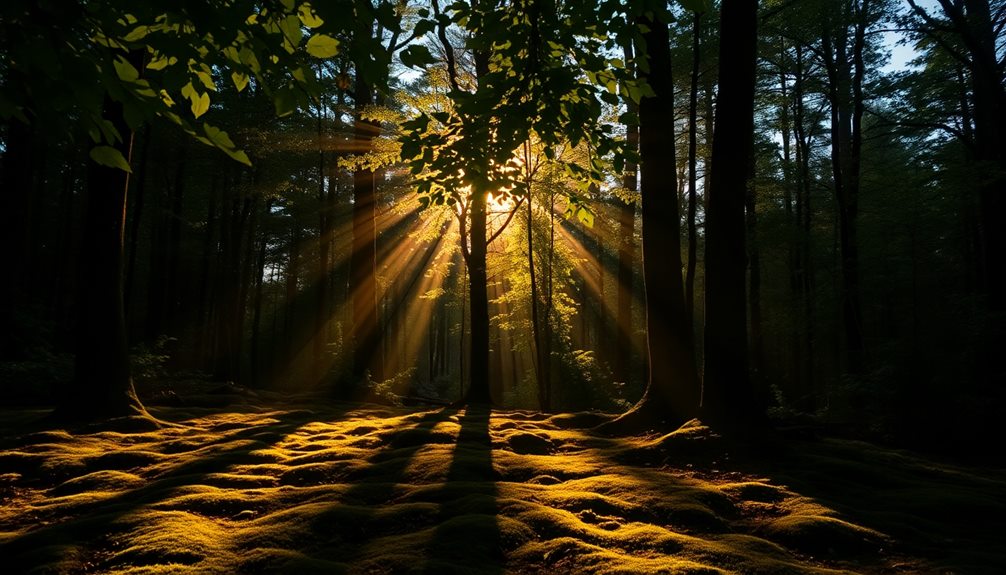
How does light behave in our environment? Light travels in straight lines, which is essential for how shadows are formed when objects block its path. The characteristics of light sources play a significant role in shaping and defining these shadows. For instance, the intensity and angle of a light source can drastically influence the clarity and shape of the shadows cast.
As the day progresses, shadows change in length and intensity, particularly due to the sun's position in the sky. When you experience hard light, like direct sunlight, you'll notice sharp-edged shadows that clearly outline the object. Conversely, soft light, such as that from an overcast sky, creates blurred edges, giving shadows a more diffused appearance.
Additionally, the surface on which a shadow falls can alter its shape dramatically. Textured surfaces can create unique effects, making the shadow appear distorted or intriguingly patterned.
Practical Applications in Art

Light and shadow play crucial roles in creating depth and realism in art. By understanding how light hits your subject, you can enhance composition and draw attention to focal points. Observational drawing from life deepens your connection with the subject, helping you recognize how light and shadow interact naturally. This awareness allows you to depict more lifelike representations in your artwork.
Mastering techniques like hatching, blending, and stippling is essential for creating texture and depth. These methods enable you to represent light and shadow effectively, making your pieces more dynamic. Using reference images can greatly aid your understanding of light's behavior, improving your color choices and refining your shadow painting skills.
Don't hesitate to experiment with different pigments and layering colors. This practice helps you achieve desired effects in shadow areas, fostering a nuanced understanding of value and temperature.
Ultimately, the practical applications of light and shadow in your art can transform your work from flat to immersive, inviting viewers to engage with the depth and realism you've crafted. By applying these techniques, you'll see the dramatic impact of light and shadow in your creations.
Resources for Learning
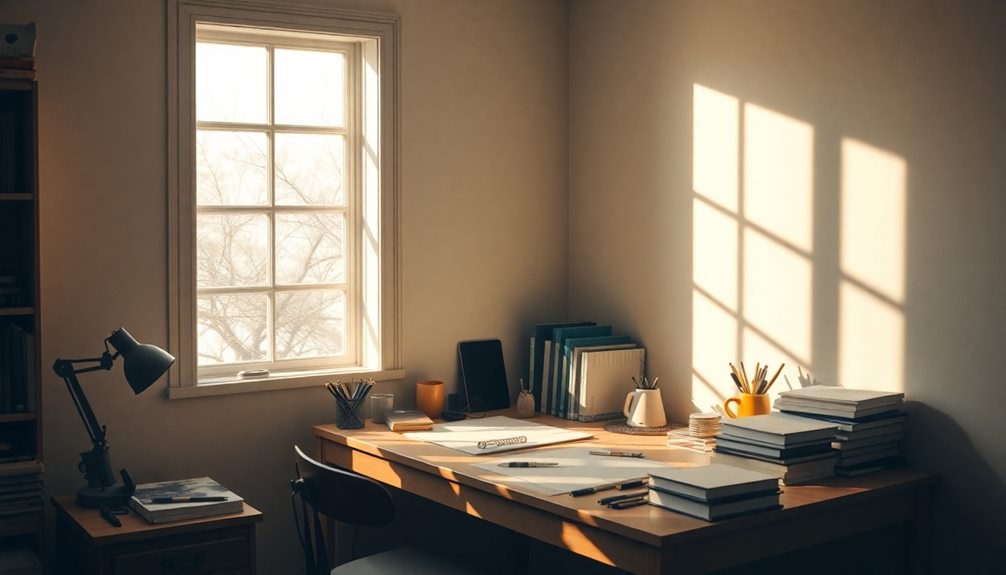
Mastering the interplay of light and shadow is a journey that benefits from a variety of learning resources.
First, painting from life is essential; it sharpens your observational skills and helps you grasp how light interacts with objects. Set up a still life scene and focus on capturing the lightest part of each object, noticing how shadows form and change.
Online tutorials and courses focused on color theory and shadow painting offer structured learning tailored for any skill level. They break down complex concepts, making them easier to understand.
Additionally, community workshops provide hands-on experiences where you can practice techniques and receive constructive feedback from peers.
Don't underestimate the power of networking; connect with other artists through social media and local art groups. They can inspire you with their insights and share valuable tips for mastering light and shadow.
Frequently Asked Questions
How to Understand Light and Shadow?
To understand light and shadow, observe how light interacts with objects around you. Experiment with different angles and intensities, noting how shadows change. Practice regularly, and soon you'll grasp their dynamics in your artwork.
What Does the Light and Shadow Symbolize?
When you think of light and shadow, imagine a candle flickering in a dark room. Light symbolizes knowledge and clarity, while shadow represents ignorance and mystery, illustrating the constant dance between understanding and the unknown within you.
What Is the Concept of Light and Shadow?
Light and shadow represent contrasting elements in visual perception. You see light illuminating objects, while shadows create depth and dimension. Together, they enhance your understanding of form, emphasizing beauty and complexity in your surroundings.
What Is the Technique of Light and Shadow?
When you dance with light, you embrace shadows that reveal depth. You'll master techniques like hatching and blending, creating enchanting visuals that breathe life into your artwork, transforming flat surfaces into vibrant, three-dimensional experiences.
Conclusion
So, as you immerse yourself in the world of light and shadow, you might find it amusing that the very absence of light creates depth and dimension in your art. Embracing shadows isn't just about darkening areas; it's a dance of contrasts that brings your work to life. By mastering these elements, you'll discover that the darkness you once feared is actually your greatest ally in shaping brilliance. Who knew shadows could shine so brightly in your artistic journey?
